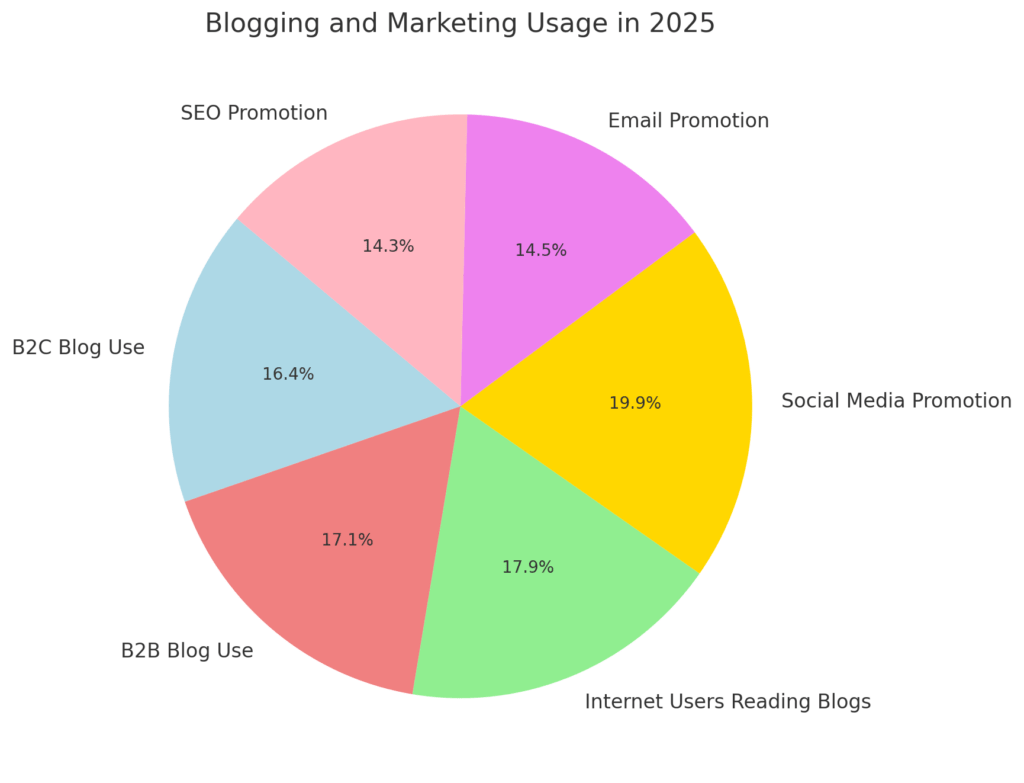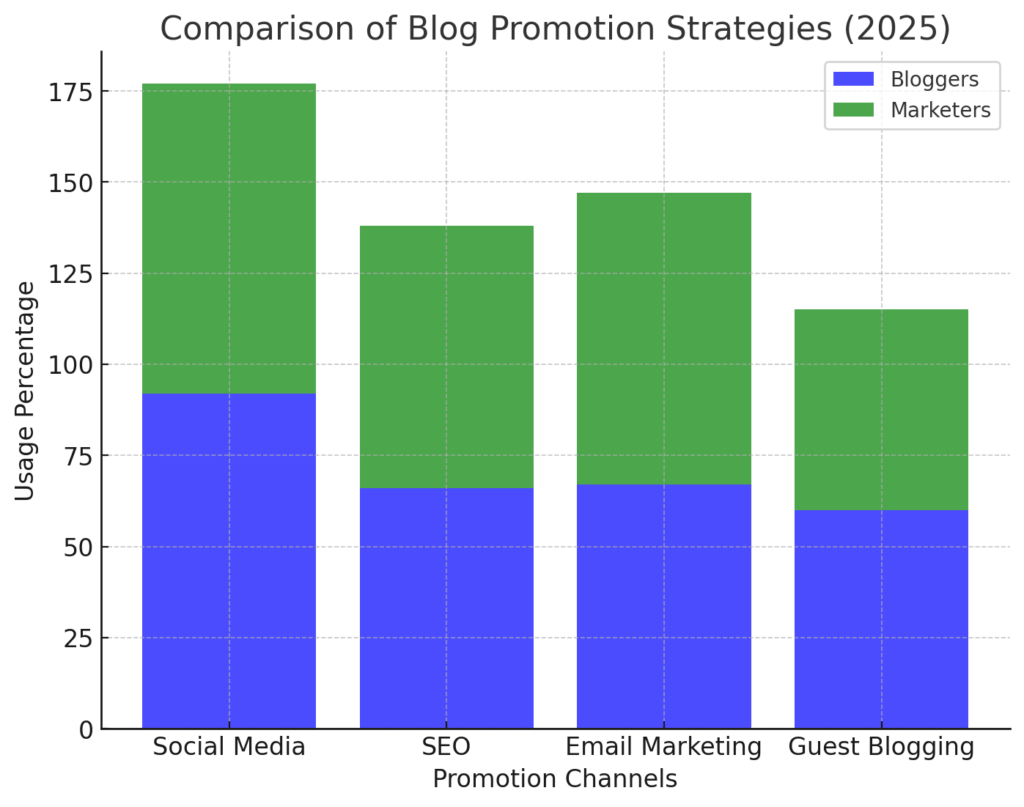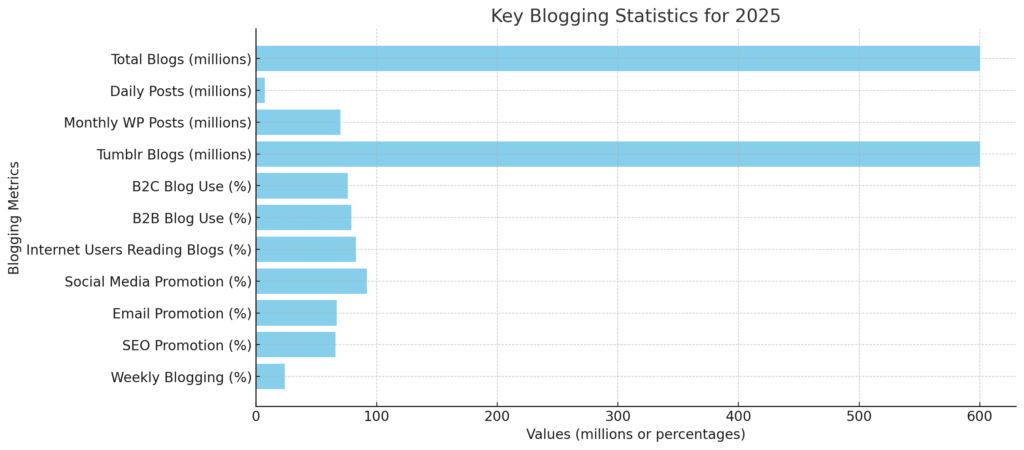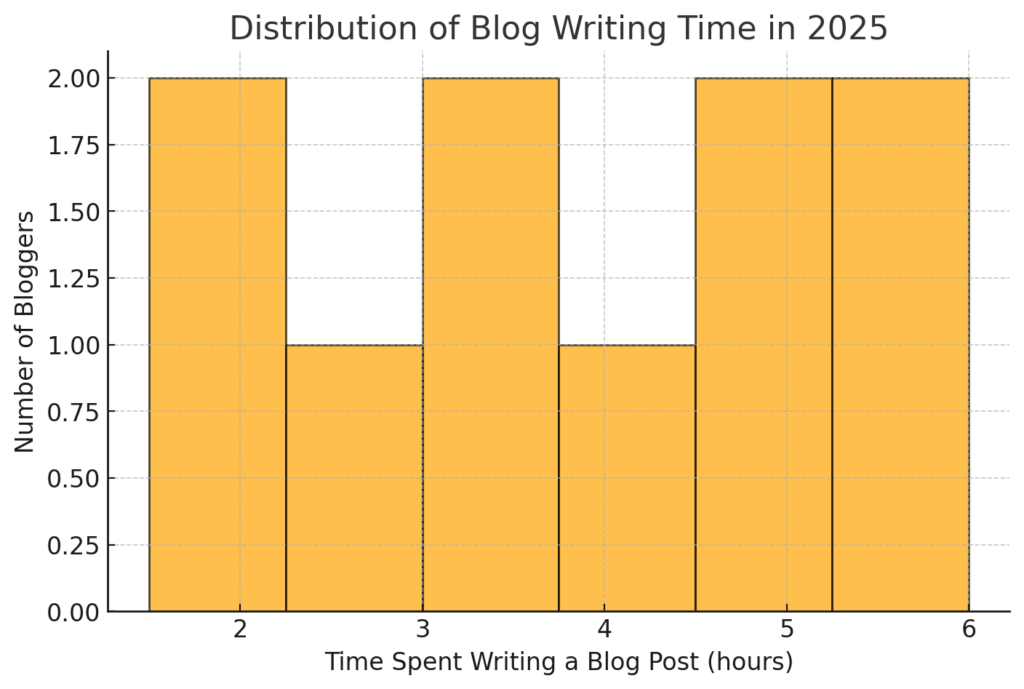
14 Mar BEST BLOGGING STATISTICS 2025
Blogging continues to evolve, shaping how businesses, creators, and individuals connect with their audiences. With over 600 million blogs online and millions of posts published daily, standing out requires more than just frequent updates—it demands strategy, originality, and adaptability. Amra and Elma recognizes that emerging trends, from AI-driven content creation to interactive storytelling, are redefining how blogs engage readers and drive conversions. As search engines prioritize quality and user experience, long-form, multimedia-rich, and mobile-optimized content is becoming the new standard. Monetization strategies are also shifting, with more bloggers leveraging premium content, memberships, and AI-powered personalization to maximize revenue. These 20 blogging statistics not only highlight the current state of the industry but also provide insights into where it’s headed. Understanding these trends will be key for anyone looking to maintain relevance and success in the rapidly evolving digital landscape.
BEST BLOGGING STATISTICS 2025 (Editor’s Choice)
Blogging has evolved significantly over the years, with notable trends emerging in 2025. Here are 20 key statistics that highlight the current state and historical progression of blogging:
1. Global Blog Count: As of 2025, there are over 600 million blogs worldwide, accounting for approximately one-third of all websites.
2. Daily Blog Posts: Approximately 7.5 million blog posts are published daily, totaling over 2.5 billion annually.
3. WordPress Activity: Each month, around 70 million new posts and 77 million new comments are made on WordPress alone.
4. Tumblr Blogs: Tumblr hosts more than 600 million blogs as of 2025.
5. B2C Content Distribution: 76% of B2C marketers have utilized blogs for content distribution in the past year, making it the second most popular channel after social media.
6. B2B Content Distribution: 79% of B2B marketers use blogs to distribute content.
7. Reading Habits: 83% of internet users read blogs at least once a month.
8. Content Promotion Channels: The most popular channels for promoting blog content are social media (92%), email marketing (67%), and SEO (66%).
9. Blogging Frequency: 24% of bloggers publish new posts on a weekly basis.
10. Average Writing Time: The average time spent writing a blog post is 3 hours and 48 minutes.
11. Average Post Length: The typical blog post length is 1,394 words.
12. Content Length and Results: Bloggers who write posts over 2,000 words are more likely to report strong results.
13. AI Adoption: 65% of bloggers use AI tools at least occasionally, primarily for generating ideas (43%), writing headlines (29%), and creating outlines (28%).
14. Mobile Optimization: Mobile-friendly blogs are 24% more likely to be ranked highly by search engines.
15. Visual Content Usage: Blog posts with images receive 94% more views than those without.
16. Guest Blogging: 60% of bloggers write 1-5 guest posts per month.
17. Monetization: Bloggers who earn over $50,000 annually publish posts averaging 2,424 words in length.
18. Content Skimming: 73% of readers admit to skimming blog posts rather than reading them thoroughly.
19. Blogging ROI: Brands that prioritize blogging are 13 times more likely to see a positive ROI.
20. Lead Generation: Companies with blogs produce 67% more leads monthly compared to those without.
These statistics underscore the enduring significance of blogging in digital marketing and content consumption, highlighting its evolution and current trends in 2025

BEST BLOGGING STATISTICS 2025 and Future Implications
BEST BLOGGING STATISTICS 2025 #1. Global Blog Count
With over 600 million blogs worldwide, blogging remains a dominant force in digital content. The sheer volume of blogs suggests a highly competitive landscape where standing out requires strong SEO strategies and unique, high-quality content. As AI-generated content becomes more prevalent, originality and authenticity will play an even greater role in engaging audiences. The rise in blog numbers also indicates a growing reliance on digital storytelling for brand building, personal expression, and thought leadership. This trend will likely push platforms like Medium, WordPress, and Substack to innovate, offering better monetization and distribution tools. In the future, niche blogging may gain traction as a way to combat content saturation. Bloggers who establish authority in specialized topics will have an advantage in securing dedicated readerships.
BEST BLOGGING STATISTICS 2025 #2. Daily Blog Posts
Publishing 7.5 million blog posts daily underscores the vast amount of content competing for readers’ attention. This flood of information means that content marketing strategies must evolve to prioritize engagement over volume. Brands and independent bloggers will need to focus on long-form, research-driven, and interactive content to retain their audience. AI-powered personalization could help tailor blog recommendations, ensuring users see relevant posts instead of generic articles. With so many posts published each day, social media amplification and strategic email marketing will become even more essential. Additionally, search engine algorithms will continue refining ranking factors to reward well-researched and valuable content. Moving forward, AI-assisted writing tools will streamline blog creation, but human creativity and emotional resonance will still differentiate top-performing posts.
BEST BLOGGING STATISTICS 2025 #3. WordPress Activity
WordPress hosting over 70 million new posts and 77 million comments per month highlights its dominance as a blogging platform. This level of activity suggests that despite emerging platforms like Substack and Ghost, WordPress remains a preferred choice due to its customization options and SEO-friendly features. However, increased competition means that WordPress users must leverage plugins, structured content, and multimedia elements to maintain engagement. The high volume of comments signals the importance of community interaction in blogging, reinforcing the idea that engagement metrics will be key to ranking and reader retention. With AI-powered tools integrating into WordPress, content recommendations and automated SEO improvements will become standard. Moving forward, WordPress may further invest in AI-driven analytics and content structuring features to keep up with evolving user needs. The future of blogging on WordPress will likely shift toward a hybrid model where AI supports, but does not replace, human writers.
BEST BLOGGING STATISTICS 2025 #4. Tumblr Blogs
Despite being overshadowed by newer platforms, Tumblr’s 600 million blogs indicate a persistent niche for creative and visual-heavy blogging. Unlike traditional SEO-driven blogs, Tumblr thrives on community engagement, meme culture, and multimedia content. This suggests that the future of blogging may not be solely about long-form text but also about integrating GIFs, short posts, and microblogging elements. With Gen Z increasingly favoring visual content, platforms like Tumblr may experience a resurgence, especially if they integrate AI-powered discovery features. The challenge for Tumblr bloggers will be maintaining authenticity while adapting to an ever-changing internet culture. Moving forward, microblogging platforms may leverage blockchain-based monetization or NFT-based content ownership. In the long run, platforms with highly engaged niche communities will remain competitive despite the rise of mainstream blogging alternatives.
BEST BLOGGING STATISTICS 2025 #5. B2C Content Distribution
With 76% of B2C marketers using blogs for content distribution, blogging remains a critical tool for reaching consumers. Unlike traditional advertising, blogs allow brands to build trust and provide value through educational and informative content. The effectiveness of blog-driven content marketing suggests that future advertising will focus more on storytelling than hard sales tactics. Brands that invest in data-driven content strategies will be able to optimize their blogs for different audience segments. With AI-generated content becoming more common, brands will need to focus on personalized and interactive experiences to keep readers engaged. As competition increases, blogs that integrate video, interactive infographics, and user-generated content will perform better. The future of B2C blogging will likely involve more integration with e-commerce, where blogs serve as a direct funnel to product purchases.

BEST BLOGGING STATISTICS 2025 #6. B2B Content Distribution
The fact that 79% of B2B marketers use blogs for content distribution highlights their role in lead generation and brand positioning. B2B audiences tend to value data-driven, well-researched content, making long-form articles, white papers, and case studies highly effective. As decision-makers seek authoritative insights, the demand for expert-driven content will grow, making collaborations with industry leaders and guest bloggers more valuable. The rise of AI-assisted content creation will streamline research and draft generation, but thought leadership will remain a key differentiator. SEO and LinkedIn amplification will continue to be critical for blog visibility in the B2B space. Looking ahead, B2B blogging may integrate more AI-powered personalization, tailoring content based on visitor intent and past engagement. Companies that align their blogs with evolving search behaviors and AI-driven analytics will maintain a competitive edge.
BEST BLOGGING STATISTICS 2025 #7. Reading Habits
With 83% of internet users reading blogs monthly, blogging remains an essential part of online information consumption. This statistic underscores the need for businesses, influencers, and thought leaders to maintain an active blog presence. The challenge, however, is standing out in an oversaturated market where attention spans are shrinking. To keep readers engaged, blog formats will likely evolve to incorporate more multimedia elements, such as embedded videos and interactive visuals. AI-powered content recommendations will also enhance personalization, ensuring that readers find relevant blogs based on browsing habits. The future of blog readership may lean toward shorter, more digestible content optimized for mobile consumption. However, long-form blogs will still hold value for in-depth research and high-authority topics.
BEST BLOGGING STATISTICS 2025 #8. Content Promotion Channels
With 92% of blogs promoted via social media, 67% through email marketing, and 66% via SEO, multichannel distribution is crucial. Relying solely on organic search is no longer enough, as social algorithms and email engagement strategies become key factors in blog visibility. The effectiveness of email marketing suggests that owned channels remain valuable despite the dominance of social media platforms. Looking ahead, AI-powered analytics will help optimize promotion strategies, identifying the best distribution methods for specific audiences. Personalized email sequences and AI-driven social media content suggestions will further refine promotion techniques. The growing emphasis on short-form content means that blog excerpts, Twitter threads, and LinkedIn posts will be used more frequently to drive traffic. Future blogs will need to be crafted with distribution in mind, ensuring adaptability across multiple platforms.
BEST BLOGGING STATISTICS 2025 #9. Blogging Frequency
With 24% of bloggers publishing weekly, consistency remains key for audience retention and SEO performance. However, quality is increasingly outweighing quantity, as longer, more detailed posts tend to rank better and drive more engagement. Bloggers who publish weekly must balance depth with timeliness, ensuring that posts remain relevant without sacrificing quality. As AI tools assist with content generation, the pressure to produce frequent content may shift toward optimizing existing posts for better performance. Blogs that incorporate evergreen content strategies will see long-term benefits, as search engines favor authoritative pages that continually provide value. The future of blogging may involve dynamic content updates, where AI tools automatically refresh articles based on changing trends and new data. Those who strike the right balance between frequency and substance will maintain a loyal readership.
BEST BLOGGING STATISTICS 2025 #10. Average Writing Time
The average blog post takes nearly four hours to write, reflecting the increasing complexity of high-performing content. Bloggers are investing more time in research, formatting, and SEO optimization, suggesting that surface-level content is no longer enough. As AI writing tools improve, they may help speed up initial drafts, allowing bloggers to focus on refinement and personal insights. The increased writing time also indicates a shift toward storytelling, as brands and individuals aim for deeper audience engagement. With the rise of AI-assisted research, bloggers can spend more time on analysis and less on data gathering. In the future, hybrid content strategies—combining AI-generated summaries with human-written analysis—could redefine the writing process. Despite automation, the human element of blogging, including personal voice and experience, will remain irreplaceable.

BEST BLOGGING STATISTICS 2025 #11. Average Post Length
With the typical blog post averaging 1,394 words, content length plays a critical role in search engine rankings and reader engagement. This suggests that concise yet informative writing is becoming the standard, balancing depth with readability. While longer posts (over 2,000 words) often perform better for SEO, the key is structuring content in a way that remains digestible. The use of headings, bullet points, and visuals will continue to be essential for improving reader experience. As AI-powered content generation tools improve, writers may be able to generate detailed drafts more efficiently while focusing on refining insights. Moving forward, blogs with data-driven insights, storytelling elements, and interactive components will stand out in an increasingly crowded space. Bloggers who optimize for both search engines and human readers will have a competitive edge.
BEST BLOGGING STATISTICS 2025 #12. Content Length and Results
Bloggers who write posts over 2,000 words tend to see stronger results, reinforcing the idea that in-depth content is more valuable. This suggests that search engines and readers prefer comprehensive content that thoroughly answers queries. While short-form content remains popular on social media, long-form blogs dominate in thought leadership and educational niches. The challenge will be maintaining engagement throughout longer posts, making readability and formatting more important than ever. Future blogging strategies may focus on modular content—where longer articles are broken into digestible sections that can be repurposed for social media. AI tools will likely help writers identify content gaps, ensuring that long-form posts provide unique value rather than fluff. As attention spans shorten, interactivity (videos, quizzes, and infographics) will play a key role in sustaining reader interest.
BEST BLOGGING STATISTICS 2025 #13. AI Adoption in Blogging
With 65% of bloggers using AI tools for content ideation, headline writing, and outlining, AI’s role in blogging is undeniable. While AI streamlines content creation, it also raises concerns about originality and authenticity. Writers who rely too heavily on AI-generated content may struggle to establish a distinct voice, making personalization crucial. The future of blogging will likely involve a hybrid approach—AI-assisted drafting combined with human refinement for depth and emotional appeal. As AI continues to improve, bloggers may shift from focusing on raw content production to curation and editorial oversight. Platforms that integrate AI-powered SEO analysis and real-time content recommendations will gain an advantage. Ultimately, AI will not replace bloggers but will redefine workflows, allowing for more efficient and strategic content creation.
BEST BLOGGING STATISTICS 2025 #14. Mobile Optimization Impact
Blogs optimized for mobile are 24% more likely to rank higher, emphasizing the importance of mobile-first design. As mobile traffic surpasses desktop usage, ensuring fast load times, responsive design, and easy navigation is critical. Google’s mobile-first indexing further reinforces that blogs must be designed with smartphone users in mind. Future blog development may focus on interactive storytelling, where scrollable experiences and dynamic elements enhance user engagement. AI-driven personalization could optimize mobile content, serving customized reading experiences based on user behavior. Additionally, voice search compatibility will become more important, influencing how bloggers structure content for featured snippets. Blogs that ignore mobile optimization will see declining traffic and engagement, making mobile-first strategies essential for sustained growth.
BEST BLOGGING STATISTICS 2025 #15. Visual Content’s Role in Blogging
Blog posts with images receive 94% more views, demonstrating the power of visual storytelling. The rise of image-heavy platforms like Instagram and TikTok suggests that text-based blogs must evolve to integrate multimedia effectively. Infographics, embedded videos, and interactive visuals will become standard features to enhance engagement. AI tools can assist in generating high-quality, on-brand images and videos, making multimedia integration easier. As attention spans shrink, visually engaging content will be key to retaining readers and encouraging social sharing. Future blogs may use augmented reality (AR) or immersive storytelling elements to create richer experiences. Those who invest in high-quality visuals will gain a competitive advantage, particularly in industries where aesthetics matter.

BEST BLOGGING STATISTICS 2025 #16. Guest Blogging Trends
With 60% of bloggers writing one to five guest posts per month, collaboration remains a powerful strategy for expanding reach. Guest blogging helps build credibility, improve SEO rankings, and drive traffic from authoritative sources. However, as search engines refine backlink algorithms, low-quality guest posts will lose effectiveness. Moving forward, guest blogging will shift toward high-value partnerships, where in-depth contributions provide genuine insight rather than keyword stuffing. AI tools may help match guest bloggers with relevant opportunities, streamlining outreach efforts. As personal branding grows in importance, guest posts may evolve into multimedia collaborations, including podcast appearances and video interviews. The most successful guest bloggers will prioritize quality over quantity, focusing on building long-term partnerships with reputable platforms.
BEST BLOGGING STATISTICS 2025 #17. Monetization Strategies for Bloggers
Bloggers earning over $50,000 annually tend to publish posts averaging 2,424 words, highlighting the link between content depth and revenue. Longer content allows for more strategic keyword placement, increasing organic traffic and advertising potential. Monetization strategies will likely diversify, with premium content models, memberships, and affiliate marketing playing larger roles. AI-driven analytics will help bloggers optimize conversion rates, tailoring content recommendations for individual readers. As platforms like Substack and Patreon grow, direct audience monetization will become more common, reducing reliance on traditional ad revenue. Future bloggers may leverage blockchain-based microtransactions, allowing readers to support content on a pay-per-read basis. Those who treat blogging as a business—focusing on audience retention and diversified income streams—will see the greatest financial success.
BEST BLOGGING STATISTICS 2025 #18. Content Skimming Behavior
With 73% of readers skimming blog posts, structuring content for readability is more important than ever. This trend suggests that while long-form content performs well for SEO, it must be formatted for quick consumption. Subheadings, bullet points, and bolded key takeaways will help capture attention in an age of information overload. Future blog designs may incorporate AI-driven summaries, allowing readers to grasp main points instantly. Interactive elements, such as collapsible sections or scroll-triggered highlights, could enhance engagement. The challenge will be balancing depth with accessibility, ensuring that readers stay engaged without feeling overwhelmed. As attention spans continue to shrink, the most effective blogs will master the art of concise yet informative storytelling.
BEST BLOGGING STATISTICS 2025 #19. Blogging and ROI
Brands that prioritize blogging are 13 times more likely to see a positive ROI, reinforcing its value as a long-term marketing strategy. Unlike paid ads, blog content continues to generate traffic and leads long after publication. Future ROI strategies will focus on integrating blogs with email marketing, automation, and data-driven personalization. AI-powered analytics will help brands measure content performance more effectively, identifying which topics drive conversions. Blogs will also play a greater role in e-commerce, with shoppable content and direct purchase links becoming more common. As brands refine their content marketing strategies, blogs will serve as the backbone of digital engagement, leading to higher conversion rates. Those who invest in high-quality, evergreen content will continue to see sustained returns over time.
BEST BLOGGING STATISTICS 2025 #20. Lead Generation via Blogging
Companies with blogs generate 67% more leads per month than those without, making content marketing a crucial part of business growth. Blog-driven lead generation works best when paired with strategic calls to action, gated content, and personalized email follow-ups. AI-driven chatbots and recommendation engines will enhance blog-based lead capture, offering real-time engagement. As data privacy concerns grow, first-party data collection through blogs will become even more valuable for marketers. Future blogging strategies may integrate interactive quizzes, surveys, and AI-generated insights to drive lead engagement. Blogs that align with evolving search behaviors and user intent will maintain strong lead-generation capabilities. In the coming years, businesses that treat blogging as a dynamic, interactive experience will outperform those relying solely on traditional written content.
The Future of Blogging: Innovation, Adaptation, and Growth
Blogging remains a powerful tool for content marketing, audience engagement, and revenue generation, but success now depends on innovation and adaptability. As AI continues to shape content creation, bloggers must find the balance between efficiency and authenticity to maintain trust with readers. The increasing importance of long-form, visually engaging, and mobile-optimized content highlights the need for strategic storytelling that caters to both search engines and human readers. With content saturation at an all-time high, niche expertise, interactive elements, and personalized experiences will define the next wave of blogging success. Monetization strategies will also evolve, favoring direct audience support and AI-driven optimization for lead generation. As blogging platforms integrate more advanced tools, those who embrace emerging trends while maintaining originality will thrive. In the years ahead, the most successful bloggers and brands will be those who view content not just as a marketing tool but as an evolving digital experience.
Sources:
- https://www.wix.com/blog/blogging-statistics-and-facts
- https://optinmonster.com/blogging-statistics
- https://ahrefs.com/blog/blogging-statistics
- https://www.wix.com/blog/blogging-statistics-and-facts
- https://backlinko.com/blogging-stats
- https://backlinko.com/blogging-stats
- https://backlinko.com/blogging-stats
- https://www.orbitmedia.com/blog/blogging-statistics
- https://bloggingwizard.com/blogging-statistics
- https://www.orbitmedia.com/blog/blogging-statistics
- https://www.orbitmedia.com/blog/blogging-statistics
- https://www.orbitmedia.com/blog/blogging-statistics
- https://backlinko.com/blogging-stats
- https://optinmonster.com/blogging-statistics
- https://optinmonster.com/blogging-statistics
- https://meetanshi.com/blog/blogging-statistics
- https://www.smallbizgenius.net/by-the-numbers/blogging-statistics
- https://www.smallbizgenius.net/by-the-numbers/blogging-statistics
- https://www.nptechforgood.com/101-best-practices/blogging-statistics-for-nonprofits
- https://www.nptechforgood.com/101-best-practices/blogging-statistics-for-nonprofits

